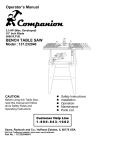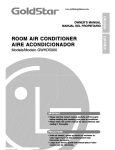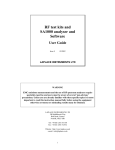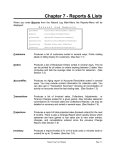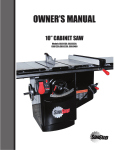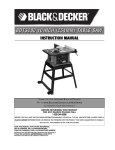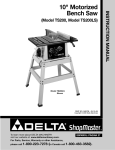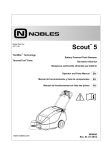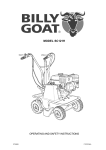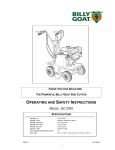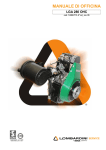Download Wilton 8201VS Operating instructions
Transcript
This Manual is Bookmarked Operating Instructions — Parts Manual 14-Inch Vertical Band Saws Models: 8201, 8203, 8201VS and 8203VS WHM TOOL GROUP 2420 Vantage Drive Elgin, Illinois 60123 Ph.: 800-274-6848 www.wmhtoolgroup.com Part No. 9078171 Revision C2 04/07 Copyright © 2007 WMH Tool Group Table of Contents Cover Page .................................................................................................. 1 General Specifications ................................................................................. 4 Operating Precautions ................................................................................. 5 Set-up and Operation ................................................................................... 7 Wiring Diagrams .......................................................................................... 8 Operating Instructions ................................................................................ 10 Maintenance .............................................................................................. 14 Troubleshooting .......................................................................................... 18 Replacement Parts..................................................................................... 19 3 General Specifications Wilton’s 14-inch Tradesman Vertical Band Saws are specially designed to effectively cut a variety of materials including wood, plastic, bakelite, composites, ferrous and non-ferrous metals. Models 8201 and 8203 are wood and metal cutting band saws. Wilton’s Model 8201VS and 8203VS 14-inch Tradesman Variable Speed Band Saws are ideally suited for metal cutting only with an infinitely variable speed range from 116 to 334 SFPM. The variable speed drive system allows the operator to fine-tune the blade speed to the material being cut to maximize the life of today’s bi-metal blades. These versatile and dependable saws are capable of contour cutting, straight cutting and re-sawing, and these band saws can cut delicate curves in thick or thin stock. 4 Specifications Capacity 8201 8203 8201VS Standard .............. 6-in. under guide ..... 6-in. under guide ....... 6-in. under guide ...... With 12-in. Riser .. 12-in. under guide ... 12-in. under guide ..... 12-in. under guide .... Blade to frame ..... 13.5-in. .................... 13.5-in. ..................... 13.5-in. ..................... Motor Rating .................. 1 HP 1-Ph ............... 1 HP 3-Ph ................. 1 HP 1-Ph ................ Voltage ................. 115 vac .................... 220/440 vac .............. 115 vac .................... Speed .................. 1725 rpm ................. 1725 rpm .................. 1725 rpm .................. Cutting Speeds Wood (SFPM) ...... 3300 ........................ 3300 ......................... 2600 ......................... Metal (SFPM) ....... 39, 57, 78, 107, ....... 39, 57, 78, 107, ........ 116 – 334 ................. 142, 196, 278 .......... 142, 196, 278 ............ Variable Speed ......... Dimensions Length ................. 20 Inches ................ 20 Inches .................. 20 Inches ................. Width ................... 16 Inches ................ 16 Inches .................. 16 Inches ................. Height .................. 66 Inches ................ 66 Inches .................. 66 Inches ................. Height from Floor ..... 66 Inches ................ 66 Inches .................. 66 Inches ................. Table Tilt to Right ..... 45 Degrees ............. 45 Degrees ............... 45 Degrees .............. Table Tilt to Left ....... 10 Degrees ............. 10 Degrees ............... 10 Degrees .............. Miter Gauge Groove Width ................... 3/4-Inch ................... 3/4-Inch .................... 3/4-Inch .................... Depth ................... 3/8-Inch ................... 3/8-Inch .................... 3/8-Inch .................... Miter Gauge ............. Standard .................. Standard ................... Standard .................. Blade Dimension Standard .............. 3/8x0.025x92.5 In. ... 3/8x0.025x92.5 In. .... 3/8x0.025x92.5 In. ... 8203VS 6-in. under guide 12-in. under guide 13.5-in. 1 HP 3-Ph 220/440 vac 1725 rpm 2600 116 – 334 Variable Speed 20 Inches 16 Inches 66 Inches 66 Inches 45 Degrees 10 Degrees 3/4-Inch 3/8-Inch Standard 3/8x0.025x92.5 In. - Misuse of this machine can cause serious injury. - For safety, machine must be set up, used and serviced properly. - Read, understand and follow instructions in the Operating Instructions and Parts Manual which was shipped with your machine. When Setting up Machine: - Always avoid using machine in damp or poorly lighted work areas. - Always be sure the machine support is securely anchored to the floor or the work bench. When Using Machine: - Always wear safety glasses with side shields (See ANSI Z87.1) - Never wear loose clothing or jewelry. - Never overreach - you may slip and fall. When Servicing Machine: - Always disconnect the machine from its electrical supply while servicing. - Always follow instructions in Operating Instructions and Parts Manual when changing accessory tools or parts. - Never modify the machine without consulting Wilton Corporation. You - the Stationary Power Tool User - Hold the Key to Safety. Read and follow these simple rules for best results and full benefits from your machine. Used properly, Wilton’s machinery is among the best in design and safety. However, any machine used improperly can be rendered inefficient and unsafe. It is absolutely mandatory that those who use our products be properly trained in how to use them correctly. They should read and understand the Operating Instructions and Parts Manual as well as all labels affixed to the machine. Failure to follow all of these warnings can cause serious injuries. Machinery General Safety Warnings 1. Always wear protective eye wear when operating machinery. Eye wear shall be impact resistant, protective safety glasses with side shields which comply with ANSI Z87.1 specifications. Use of eye wear which does not comply with ANSI Z87.1 specifications could result in severe injury from breakage of eye protection. 2. Wear proper apparel. No loose clothing or jewelry which can get caught in moving parts. Rubber soled footwear is recommended for best footing. 3. Do not overreach. Failure to maintain proper working position can cause you to fall into the machine or cause your clothing to get caught pulling you into the machine. 4. Keep guards in place and in proper working order. Do not operate the machine with guards removed. 5. Avoid dangerous working environments. Do not use stationary machine tools in wet or damp locations. Keep work areas clean and well lit. 6. Avoid accidental starts by being sure the start switch is OFF before plugging in machine. 7. Never leave the machine running while unattended. Machine shall be shut off whenever it is not in operation. 8. Disconnect electrical power before servicing. Whenever changing accessories or general maintenance is done on the machine, electrical power to the machine must be disconnected before work is done. 9. Maintain all machine tools with care. Follow all maintenance instructions for lubricating and the changing of accessories. No attempt shall be made to modify or have makeshift repairs done to the machine. This not only voids the warranty but also renders the machine unsafe. 10. Machinery must be anchored to the floor. 11. Secure work. Use clamps or a vise to hold work, when practical. It is safer than using your hands and it frees both hands to operate the machine. 12. Never brush away chips while the machine is in operation. 13. Keep work area clean. Cluttered areas invite accidents. 14. Remove adjusting keys and wrenches before turning machine on. 15. Use the right tool. Don’t force a tool or attachment to do a job it was not designed for. 16. Use only recommended accessories and follow manufacturers instructions pertaining to them. 17. Keep hands in sight and clear of all moving parts and cutting surfaces. 18. All visitors should be kept at a safe distance from the work area. Make the workshop completely 5 safe by using padlocks, master switches, or by removing starter keys. 19. Know the tool you are using — its application, limitations, and potential hazards. General Electrical Cautions This saw should be grounded in accordance with the National Electrical Code and local codes and ordinances. This work should be done by a qualified electrician. The saw should be grounded to protect the user from electrical shock. Wire Sizes Conductor Length 0 - 50 Feet 50 - 100 Feet Over 100 Feet Caution: For circuits which are far away from the electrical service box, the wire size must be increased in order to deliver ample voltage to the motor. To minimize power losses and to prevent motor overheating and burnout, the use of wire sizes for branch circuits or electrical extension cords according to the following table is recommended. AWG (American Wire Gauge) Number 240 Volt Lines 120 Volt Lines No. 14 No. 14 No. 14 No. 12 No. 12 No. 8 Safety Instructions on Sawing Systems 6 1. Always wear leather gloves when handling saw blade. The operator shall not wear gloves when operating the machine. 2. All doors shall be closed, all panels replaced, andother safety guards in place prior to the machine being started or operated. 3. Be sure that the blade is not in contact with the workpiece when the motor is started. The motor shall be started and you should allow the saw to come up to full speed before bringing the saw blade into contact with the workpiece. 4. Keep hands away from the blade area. See Figure A. 5. Remove any cut off piece carefully while keeping your hands free of the blade area. 6. Saw must be stopped and electrical supply must be cut off before any blade replacement or adjustment of blade support mechanism is done, or before any attempt is made to change the drive belts or before any periodic service or maintenance is performed on the saw. 7. Remove loose items and unnecessary workpieces from area before starting machine. A B 8. Bring adjustable saw guides and guards as close as possible to the workpiece. 9. Always wear protective eye wear when operating, servicing, or adjusting machinery. Eyewear shall be impact resistant, protective safety glasses with side shields complying with ANSI Z87.1 specifications. Use of eye wear which does not comply with ANSI Z87.1 specifications could result in severe injury from breakage of eye protection. See Figure B 10. Nonslip footwear and safety shoes are recommended. See Figure C. 11. Wear ear protectors (plugs or muffs) during extended periods of operation. See Figure D. 12. The workpiece, or part being sawed, must be securely clamped before the saw blade enters the workpiece. 13. Remove cut off pieces carefully, keeping hands away from saw blade. 14. Saw must be stopped and electrical supply cut off or machine unplugged before reaching into cutting area. 15. Avoid contact with coolant, especially guarding your eyes. C D Introduction Setup and Operation This manual includes operating and maintenance instructions for the Wilton 14-Inch Tradesman Vertical Band Saws, Models 8201, 8203, 8201VS, and 8203VS. This manual also includes parts listings and illustrations of replaceable parts. Set-up Band Saw Features The band saw is shipped with the saw frame separated from the saw base. Set-up of the band saw involves installing the frame and setting-up the saw on the shop floor. Assembly of Band Saw Refer to Figures 1 through 3 for key features of the band saw machine. Refer to the Specifications section for additional information on the features and capabilities of the saw. The saw is shipped as two separate units — saw frame and base. The saw frame must, therefore, be assembled to the base. 1. Remove loose parts from the saw base and sawframe. 2. Place the base in the location in the shop and bolt the base to the floor. (See following section on spotting saw.) Put shims under the hold-down bolts as required to make sure the saw is level. 3. Place the saw frame on the base. Be sure the pulleys on the saw frame and pulleys in the base are aligned with each other. 4. Install the four bolts, upper washers, lower washers, lock washers and nuts that secure the frame to the base finger tight. Using a straight edge, align the pulleys. Then tighten the four attachment bolt and nuts. 5. Loosen the motor mounting bolts and install the drive belt(s). Blade tension adjustment knob Figure 1: Band Saw Features (Rear View) (Models 8201/8203) Saw Head Clutch Knob Gearbox Oil Level Gauge Drive Motor Variable Speed Control Pivoting Motor Mounting Plate Upper wheel ON/OFF guard switch Optional rip fence Upper drive wheel Upper blade guide support assembly Lock Knob Upper blade guide and support assembly Miter Table slot Blade guard Lower wheel guard Dust chute Lower drive wheel Lower blade guide and support assembly Base Motor Pulley Figure 2: Band Saw Features (Rear View) (Models 8201VS/8203VS) Figure 3: Band Saw Features (Front View) (All Models) 7 6. Tension the belts (refer to Changing Drive Belt Position). 7. Check gearbox fluid level in sight gauge. If required, add lubricant to bring level halfway up the sight gauge. (Two containers of Shell Spirax 90 HD gear oil are packed with the saw. The containers have sufficient amount of lubricant to fill the gearbox.) 8. Check blade tension and support mechanism adjustment (refer to Changing Saw Blades). 9. Plug the motor cable into the switch box on the saw frame. For 3-phase motors, follow the instructions in the Electrical section to complete the electrical hookup. NOTE: Observe all electrical codes. Local codes or difficult environmental conditions may demand special electrical hook-ups. Always use a licensed electrician for any special electrical hook-up. Setting-up Saw The saw should be bolted securely to the shop floor to make sure the saw is stable when sawing long, heavy or unwieldy work pieces. Always use extra support for long or heavy stock. 8 There are lugs in the bottom of the saw base for use in bolting down of the saw. After positioning the saw, open the door in the base and mark the positions of the four lug holes. Move the saw to expose the marks. Prepare for attachment as required by the attachment method being used. Install the applicalbe fasteners. Install shims as required to level the saw. Tighten the fastners to secure the saw to the floor. Electrical 2. 3. 4. 5. 6. 7. 8. the saw before attempting electrical connections. Connect the green or green-with-white-trace wire to the branch circuit ground wire. Connect the remaining three wires to the power wires in the 3-phase branch circuit. Reestablish power in the electrical branch. Turn on power to the saw motor using the switch. Observe the direction of the blade. It should be going DOWNWARD, into the slot on the table. If it is not going downward, the power wires are hooked-up incorrectly. To correct hook-up, disconnect and lock out power to the branch, again. Reverse any two of the power wires on the hook-up to the saw cable. Reestablish power in the branch and turn the saw on again. The blade should now be going downward into the table slot. Note: local electrical codes or other codes may require direct connection to a covered, protected junction box, or other electrical hook-up method. Especially under difficult industrial conditions, specialized electrical connections may be necessary. For special electrical hook-ups, a licensed electrician should be used to connect the saw to power. CAUTION: KNOW AND OBSERVE ALL LOCAL AND OTHER APPROPRIATE ELECTRICAL CODES WHEN ATTACHING THIS BAND SAW TO YOUR POWER SUPPLY. 1-ph. power source Models 8201 and 8201VS are delivered with a 115 volt single phase motor. Models 8203 and 8203VS are delivered with a 220/440 volt, 3-phase motor. When the saw is a 115 volt model, it is supplied with a standard 115 volt plug and power cord which can be plugged into any suitable branch circuit. When the saw is equipped with a 3-phase motor there will be no plug on the 4-wire cable to the saw switch box. Instead, follow these instructions to connect the 3-phase motor to the power source: Connecting to 3-phase power 1. Disconnect and lock out the branch circuit to Switch Plug Motor Green or green with white trace Ground lug 3-ph. power source Switch Plug Motor Green or green with white trace Ground lug Figure 4: Wiring Diagrams Installing Optional Frame Riser NOTE: Refer to the illustrations in the Replacement Parts section for location of the parts used on the frame riser. 1. Remove the saw blade (refer to Changing Saw Blades). 2. Remove the two screws at the top and bottom of the blade guide that holds the blade guide on the frame. WARNING: The saw must be turned off and power disconnected any time the rubber protectors are being changed. 3. Unplug the electrical cord or open the circuit breaker in the branch circuit. 4. Support the upper frame and wheel assembly with a strap attached to an overhead crane. Use additional straps to be sure the frame assembly will be held in a stable position when it is lifted off the lower frame assembly. 5. Remove the nut on the bolt that clamps the upper frame to the lower frame and remove the bolt, two washers and nut. 6. Lift the upper frame high enough off of the lower frame to clear the riser casting. 7. Be certain the mating surfaces of the lower frame, riser, and upper frame are all clean and free from dirt and debris. 8. Position the riser casting over the lower frame. Make sure the locating dowels are inserted in the mating holes in the riser casting. 9. Lower the upper frame onto the riser casting. Make sure the locating dowels fit into their mating holes. 10. Put the new (longer) attaching bolt and top washer through the upper frame and riser, into the lower frame. 11. Put a washer and nut on the bolt and tighten securely. 12. Attach the bracket hooks to the top and bottom of the blade guard using self-tapping screws. 13. Attach the blade guide using the screws that held the original (shorter) guard. 14. Remove the old (shorter) blade guide post assembly from the upper frame. 15. The guide support assembly with the carbide guides and blade support bearings should be transferred to the new, longer support rod. Several other new parts are included for this component. (Refer to the parts illustrations for more detail.) 16. Install a new 105-inch blade (refer to Changing a Blade). Make sure blade tension and tracking are checked and adjusted as required. 18. Install the extension plug cable between the motor plug and switch plug. 19. Plug the electrical cord into the power source or close the circuit breaker on the branch circuit. Operate the band saw to verify blade tracking. Installing Optional Rip Fence The rip fence slides on two rails attached at the front and rear of the work table. Install the fence mechanism as follows: NOTE: Refer to the illustrations in the Replacement Parts section for location of the parts used on the rip fence. 1. Slide the rails into the fence. 2. Ease the fence and rails into position on the table. 3. Using the four spacers and four attachment bolts, attach the rails securely to the saw table. 4. The fence can now be adjusted and used according the instructions in Adjustment and Use of Optional Rip Fence. 9 Operating Instructions Operating Controls START/STOP Switch The START/STOP switch (refer to Figure 5) is used to turn on the band saw drive motor. The START switch has a molded guard which prevent inadvertent pressing of the START pushbutton. START/STOP Switch Guarded START Switch E-Stop Figure 5. START/STOP Controls The STOP pushbutton is not guarded to allow use as an E-stop in an emergency. Variable Speed Control The variable speed control (refer to Figure 9) is used to change the speed of the saw blade. Refer to Adjusting Blade Speed for additional information on the use of the variable speed control. 10 Operating Instructions Saw blades The Wilton 14-inch saws accept blades from 1/8inch wide to 3/4-inch wide. The narrower widths are used for cutting shapes or circles; the wider widths are used for straight cuts. For straight cuts, use the widest available saw blade. A wide blade provides cutting stability, and allows for more accurate and straighter cuts. Blade speed effects the efficiency of the cut and the service life of the blade. Good shop practice requires that work-hardening materials, such as stainless steel, require the cut be completed in a single pass. Otherwise, the effect of stopping the cut can result in hardening of the cut interface. Other materials such as wood require higher blade speeds to prevent fiber tearing. The chart in Figure 6 provides suggested blade speeds for various types of materials. The recommended speeds should be decreased 30 to 50% when using carbon steel blades. (The chart provides speeds that are based on cutting a 4-inch thick work piece using a bi-metal blade without cutting fluid.) The following conditions should also be considered: 1. Increase speed 15% for materials 1/4-inch thick, 12% for 3/4-inch thick, 10% for 1 1/4inch thick, and 5% for 2 1/2-inch thick. 2. Decrease speed 12% when cutting 8-inch thick material. To avoid tooth breakage, select a blade-tooth pitch that will have two or more teeth in contact with the workpiece at all times. Different blade materials and tooth geometry (pitch and set) permit sawing a wide range of common and exotic materials. Contact your industrial distributor for recommendations on specialized blades. Using the corrrect blade can save you time, trouble, and the possibility of dulling and pemature discarding of the blade you normally might use. NOTE: Always use a sharp blade. SHARP BLADES ARE CHEAP INSURANCE AGAINST POOR CUTTING EFFICIENCY AND ACCELERATED MACHINE WEAR. Material being cut Speed (SF/M) range 165 Structural steel shapes 160-165 Low carbon steel 115 Medium carbon steel 90-100 High carbon steel 105-135 Cr-moly steel 90-115 Ni-Cr-moly steel 80-140 Chromium steel 105-115 Cr-vanadium steel 40-80 Tool steel 40-70 Stainless steel 80-100 Free machining steel 55-90 Cast iron 55 Copper alloy (CU-Zm) 90 Bronze 40 Al-bronze 40-45 Monel 25-40 Titanium alloy 3000 Aluminum (soft) 3000 Aluminum (T-6+) 3000 Carbon 80-160 Slate 3000 PTFE sheet, rod, rounds 3000 Hard rubber 3000 Plywood 3000 Other woods Figure 6. Blade Speed to Material Chart Adjustments Adjusting Blade Support/Guide Height The upper blade support and guide mechanism can be adjusted to accomodate the height of the work piece. 1. To adjust the support, loosen the knob that clamps the support rod, then move the support up or down in its holder. (Refer to Figure location of the support mechanism. 2. Adjust the support so there is space between the support and work piece. Space of approximately 1/8-inch is generally appropriate. Adjusting Blade Tension Blade tension is set by a spring loaded tension mechanism on the upper drive wheel. Check the level of the tension device before cutting. The tension for various blade widths as indicated on the casting on the tension device. Figure 8. Table Tilt Mechanism and Angle Gauge Adjusting Table Angle (Refer to Figure 8.) The angle gauge is under the front of the table. The angle gauge shows the angle of the table relative to the saw blade. The table is mounted on trunnions that allow adjustment downward 45 degrees, and upward 10 degrees. Loosen the two trunnion lock knobs slightly to adjust the table angle and retighten the lock knobs. NOTE: by adjusting the positive leveling stop on the table leveling mechanism, it is possible to tilt the table upward 10 degrees. When returning to 0 degrees, the table leveling mechanism must be reset after completing the sawing operation (refer to Machine Set-up). WARNING: When cutting at an angle with a tilted table, provide a guide against which the material being cut can rest. Cutting “freehand” at an angle, can result in injury and maintaining an accurate cut is it difficult. Leveling Work Table The table can be adjusted to level the table relative to the saw bleade. Use the following method: WARNING: The saw must be turned off and power disconnected any time the gearbox lubricant is being drained or filled. Figure 7. Saw Blade Tension and Tracking Mechanism 1. Unplug the electrical cord or open the circuit 11 2. 3. 4. 6. 7. 8. 9. 10. 11. 12 breaker in the branch circuit. Move the upper blade guide assembly to the very top of its travel. Make sure the blade is straight, and fully tensioned. (A damaged or worn blade may provide a poor reference surface for squaring the table.) Loosen the table lock knobs and hold the table firmly against its positive leveling stop. Using a machinist’s square, check to make sure the table is 90 degrees to the blade. USING LEATHER PROTECTIVE GLOVES, turn the upper drive wheel to check the squareness at a minimum of three points on the blade If the table is not level, unlock the lock nut on the table leveling bolt. Turn the leveling bolt as required to make the table square to the blade. Lock the leveling bolt lock nut and recheck the table level. When the table is level... Lock the table lock knobs securely and recheck for level. Adjust as necessary until the table is level while everything is tightened to working tightness. With everything locked down, look at the pointer for the angle gauge. It should be exactly on the zero mark of the gauge (Figure 12). If not, loosen the pointer screw, adjust the pointer until it is on zero, then tighten the pointer screw while holding the pointer securely in position on zero. Adjusting Miter Gauge Slot Parallelism The miter slot should be parallel to the side of the blade. If the saw is not cutting straight when using the miter gauge, the miter slot may not be parallel. 1. Put a straight edge against the blade. Make sure to position the blade so tooth offset does not affect the straight edge. 2. Measure from both ends of the miter slot to the straight edge.3. If the measurements are not equal at both ends of the slot, loosen six bolts securing the table to the table trunnions (see Figures 12 and 13.) 4. Adjust the table until it is parallel with the blade. 5. Tighten the trunnion attaching bolts. Adjusting Blade Speed (Models 8201/8203) Figure 6 on page 9 provides blade speeds for various materials. To adjust the blade speed, change the clutch position of the clutch (in or out) and the position of the drive belt on the pulleys on the motor and reduction gearbox shafts. Adjusting Blade Speed (Models 8201VS/8203VS) See Figure 9 at bottom of this page. 1. The blade speed is controlled by an adjustment mechanism on the right end of the saw. Speed increases or decreases as the knob is turned 2. A placard on the drive belt guard (shown below) provides recommended speeds for various materials. 3. A speed indicator is provided on the barrel of the adjustment mechanism. In surface feet per minute; Position 0 = 334, 1 = 262, 2 = 216, 3 = 171, 4 = 137, and 5 = 116. 4. Turn the speed adjustment knob to the desired setting as determined by the material being cut. Changing Clutch Position WARNING: NEVER attempt to shift the clutch mechanism while the saw is running. The saw must be turned off before clutch shifted. Speed Indicator Variable Speed Control Top View Front View Figure 9. Variable Speed Control 1. Turn the main switch to off. 2. Pull the door open on the pulley case. 3. Turn the clutch handle clockwise and push in, to engage the high speed pulley drive. Or, turn the clutch handle clockwise, and pull out, to engage the reduction gearbox drive. 5. Release the weight of motor so the motor pivots downward. The weight of the motor is provide adequate belt tension. 6. Plug the electrical cord into the power source or close the circuit breaker on the branch circuit. NOTE: When pushing or pulling the clutch knob, the dogs on the clutch mechanism are being engaged. Take the time make sure the clutch handle is all the way in, or all the way out, so the clutch dogs are in full engagement when the saw is started. 4. Close the pulley case door. 5. Plug the electrical cord into the power source or close the circuit breaker on the branch circuit. Changing Pulley-to-Belt Position Changing Drive Belt Position WARNING: The saw must be turned off and power disconnected before changing drive belt positions. Refer to Figure 9, below. 1. Unplug the electrical cord or open the circuit breaker in the branch circuit. 2. Open the door on the machine base and the door on the pulley case. 3. Push up on the motor to pivot the motor upward and slacken the drive belt. 4. Move the drive belt to the desired pulley position. NOTE: Never force the belts to change pulley location without pivoting the motor to loosen the motor belt. Failure to do so can cause damage to the drive mechanism, and accelerate belt wear and possibly result in belt failure. WARNING: NEVER attempt to change pulley shaft positions while the saw is running. The saw must be turned off and power disconnected any time pulley shaft poistions are being changed. 1. Unplug the electrical cord or open the circuit breaker in the branch circuit. 2. Open the door on the machine base and the door on the pulley case. 3. Push up on the motor to pivot the motor upward and slacken the drive belt. 4. With the motor drive belt loose, remove both pulley drive belts. 5. Both of the pulleys are secured to their shafts with two set screws. These are located in the bottoms of the V-grooves on the pulleys. Using a hex wrench, loosen (but do not remove) all four set screws. 6. Pull the pulleys straight off each shaft. 7. Put the lower pulley on the upper shaft and the upper pulley on the lower shaft. 8. Push the upper pulley firmly against the reduction gearbox and tighten the two set screws which secure it to the shaft. 9. Using a straight edge against the pulley flanges, make certain the bottom pulley is aligned with the upper pulley. Then tighten the two set screws that secure the lower pulley to the shaft. Figure 10. Clutch to Pulley Speed Settings 13 10. Install the belts as required (refer to Figure 10). 11. Release the weight of motor so the motor pivots downward. The weight of the motor will provide adequate belt tension. 12. The weight of the motor should provide sufficient tension so the the middle of the small drive belt is displaced approximately the thickness of the belt. (The high speed belt is adjusted at the same time as the smaller belt.) 13. Set the drive clutch to the desired position (IN or OUT). 14. Close the access doors. 15. Plug the electrical cord into the power source or close the circuit breaker on the branch circuit. Using Miter System A miter gauge is provided with the band saw. The miter gauge slips into a slot in the face of the work table. The miter gauge can be adjusted from 0 to 45 degrees. Adjust the miter gauge as follows: 1. Loosen the clamping screw on the miter gauge. 2. Adjust to desired angle. 3. Tighten the clamping screw. Using Rip Fence 14 1. Unlock the fence by loosening the lock knob (ref. 7) and handle (ref. 10.) 2. Slide the fence on its guides until it is the required distance from the blade. 3. Tighten the lock knob and handle, slightly. 4. Using a machinist’s square, measure the distance between the edge of the miter slot and both the front and rear of the rip fence. Adjust so both distances are equal. 5. Check the fence-to-blade gap, again. Readjust the fence, if necessary, until the blade gap is correct and the fence is parallel with the miter slot. 6. Tighten the fence firmly using the lock knob and handle. Using the Dust Control Chute On the lower side of the table, below the cutting position of the blade, is a plastic tube which can be attached to a shop vacuum, or to a shop dust control system. The dust control chute can be seen in several of the figures used to illustrate the operation of the saw. Maintenance This section contains periodic maintenance recommendations and maintenance procedures. Changing Saw Blade WARNING: The saw must be turned off and power disconnected any time saw blades are being changed. 1. Unplug the electrical cord or open the circuit breaker in the branch circuit. 2. Pull open both upper and lower drive wheel guards (refer to Figure 1). 3. Release blade tension completely by turning the tension handle fully counterclockwise. 4. Remove table leveling pin. The pin has a tight push fit in its slot; it is not threaded. (Refer to Figure 13. 5. Use a screwdriver to pop out the table insert. 6. Loosen the set screws that lock the guide blocks. Move the guide blocks outward. Then turn the micro-adjusting knob to move the blade support bearing to the very rear of its travel. 7. Using a hex wrench, loosen the set screw that locks the lower blade guide and support assembly. Move the assembly to the very rear of its travel by using the micro-adjusting knob on the back side of the assembly (refer to Figure 11). Blade support bearing Support bearing microadjusting knob Blade Guide block set screws Guide block support microadjusting knob Carbide guide blocks Figure 11. Upper Blade Guides 8. Using a hex wrench, loosen the carbide blade guide set screws. Open up a reasonably large gap between the guides; do this on both the upper and lower blade guides. 9. USING LEATHER GLOVES AND ANSI Z87.1 EYEWEAR TO PROTECT YOURSELF FROM THE CUTTING BLADE, carefully remove the blade from the drive wheels. Remove the blade out of the saw table through the table. 10. Hang the removed blade in a safe place. Leveling bolt lock nut Table leveling bolt Trunnion Blade attachment support bolts bearing NOTE: Clean out the interior of the saw with a shop vacuum. Examine the bearings and other exposed mechanisms of the saw. 11. Using protective gloves, carefully ease the replacement blade into the table slot and over the upper and lower drive wheels. NOTE: It is possible to install the blade upside down. Make sure the teeth on the blade are pointing downward. NOTE: The blade should be “free standing” at the cutting throat; the upper and lower blade guides should not touch the blade at any point. Also, make sure the blade is in the slot in the blade guard on the left side of the machine frame. Refer to Figure 1 to identify the blade guard. 12. Apply tension to the blade using the tension knob. The tension levels for various blade widths are shown on the markings on the tension device. Refer to Figure 3 for a view of the tension system. 13. Slowly turn the upper drive wheel by hand, while OBSERVING THE BLADE TRACKING. The blade should track, more or less, in the center of the drive wheel. If the blade does not track true, adjust the tracking to keep the blade centered. 14. Unlock the tilt adjustment knob by loosening its locking wing nut. Both the adjustment knob and wing nut are identified in Figure 7. 15. Turn the tilt adjustment knob (usually a VERY LITTLE at a time) to adjust the tilt of the upper drive wheel. Do this while turning the upper wheel by hand, and adjusting until the blade stays centered on the wheel. 16. Tighten the tilt mechanism locking wing nut. 17. Using the micro-adjusting knob, move the lower blade support assembly (Refer to Figure 12) forward until the support bearing just contacts the back edge of the saw blade. 18. Adjust the lower carbide blade guides until they just contact the sides of the blade. Make sure the guides DO NOT CONTACT THE TOOTH PORTION OF THE BLADE. The guides should touch only the flat part of the blade. After correctly positioning the carbide guide blocks, tighten the set screws securely. Blade guide microadjusting knob Front trunnion lock knob Carbide blade guide Guide block support Blade support bearing microadjusting knob Rear trunnion lock knob Figure 12. Lower Blade Guide Support Rear View Front trunnion Table leveling pin Lower blade support bearing Trunnion attachment bolt rear trunnion Guide block microadjusting knob Front trunnion lock knob Rear trunnion lock knob Carbide guide block Figure 13. Lower Blade Guide Supports Front View 19. Adjust the upper support assembly so the support bearing just contacts the back edge of the saw blade. 20. Adjust the upper carbide blade guides until they just make contact with the blade BEHIND THE TOOTH AREA OF THE BLADE. Then tighten the set screws securely. 21. Replace the table insert. 22. Insert the table pin into its slot. 23. Close the drive wheel guards. 24. Plug the electrical cord into power source or close the circuit breaker on the branch circuit. 25. Turn on the power and observe the action of the blade to sure the blade is correctly adjusted. 15 Draining and refilling the reduction gearbox. Blade WARNING: The saw must be turned off and power disconnected any time the gearbox lubricant is being drained or filled. Blade support bearing Guide block set screws Carbide guide block Support bearing shaft Guide block support set screw Figure 14. Lower Blade Support Assembly Replacing drive wheel rubber protectors The rubber rings that cover the drive wheels are called protectors. The protectors protect the wheel from blade damage and provide a high friction drive force on the tensioned blade. Over a long period of service, the protectors wear and may require replacement. 16 1. Unplug the electrical cord or open the circuit breaker in the branch circuit. 2. Open the door in the base. 3. Push up on the motor to loosen the drive belts. 4. Remove the pipe plug at the bottom of the gearbox. Drain the oil into a suitable container for safe and appropriate disposal. 5. Replace the drain plug. 6. Open the filler plug. 7. Add lubricant until the level is halfway up the sight gauge window (refer to Figure 15). Use Shell Spirax HD 90 gear lubricant. 8. Replace the filler plug. 9. Replace the drive belts. Allow the motor to pivot downward to apply tension to the belts. 10. Close the access door. 11. Plug the electrical cord into the power source or close the circuit breaker on the branch circuit. WARNING: The saw must be turned off and power disconnected any time the rubber protectors are being changed. 1. Unplug the electrical cord or open the circuit breaker in the branch circuit. 2. Remove the blade according to the step-bystep instructions on blade replacement. 3. Remove the rubber protectors from the drive wheels. Use a flat screwdriver blade or knife blade to loosen the protectors, being careful not to nick or score the aluminum drive wheels. 4. Clean the surface of the drive wheels. Use a solvent such as mineral spirits as required to achieve a clean, dry surface for the new protectors. 5. Carefully slip the replacement protectors onto the drive wheels. 6. Replace the saw blade and return the saw to service by following the steps in Changing Saw Blades. 7. Plug the electrical cord into the power source or close the circuit breaker on the branch circuit. Oil Level Gauge Gear Box Pulley Figure 15. Gearbox Oil Level Gauge Periodic Maintenance Refer to the Periodic Maintenance chart for maintenance that should be performed at various time intervals. Troubleshooting Refer to the Troubleshooting charts for equipment fault, probable cause and suggested remedy. Periodic Maintenance Item Action Interval Maintenance Saw blade Listen for sound of missing teeth Observe cutting action for cleanness and accuracy Listen for a poor weld — a “click” as it passes through the guide blocks Watch for signs of slippage on the drive wheels (blade occasionally slows or comes to a stop while sawing) Check bearing area for leakage of lubricant Check bearing area for leakage of lubricant Check for cleanliness Whenever operating saw Whenever operating saw Replace blade when teeth are broken Replace blade when bent — or worn — Use a wider blade for more accurate straight cuts When changing blade Use a different blade or dress the weld with a grinder. Whenever sawing Be sure you are using the correct blade tension — Check drive wheel rubber strips for cleanliness and adherence to drive wheel — replace if necessary Lower drive wheel Upper drive wheel Drive wheel rubber protectors Drive belts Reduction gearbox Monthly Replace bearing if leakage occurs Monthly Replace bearing if leakage occurs Daily and when changing blade Wipe or brush clean Check for smooth surfaces and adherence to drive wheel surface Monthly or when blade slippage occurs Clean when necessary — replace if damaged or excessively worn Check for glazing Monthly, or when slippage occurs (squealing belt) Replace a glazed belt — DO NOT USE BELT DRESSING Check sight glass for level — should be to halfway point on sight glass Daily Fill up to half-way point on sight glass with Shell Spirax HD 90 Annually Drain and refill with Shell Spirax HD 90 17 Blade support bearings Check for wear, damage or lubricant leakage Monthly and when changing blade Replace when necessary Carbide blade guides Check for excessive wear When changing blade Replace if excessively worn Troubleshooting Fault Probable cause Suggested remedy Excessive blade breakage 1. Material loose in vise. 2. Incorrect speed or feed. 1. Clamp work securely. 2. Refer to Figure 6 or check Machinist’s Handbook for speed/ feed appropriate for the material being cut. 3. Check Machinist’s Handbook for recommended blade type. 4. Adjust blade tension to the point where the blade just does not slip on the wheel. 5. Start the motor before placing the saw on the workpiece. 6. Adjust blade tracking. 7. Adjust guides. 8. Longer annealing cycle. 3. Teeth too coarse for material. 4. Incorrect blade tension. 5. Saw blade contacts workpiece before the saw is started. 6. Blade rubs on the wheel flange. 7. Misaligned guides. 8. Cracking at weld. Premature blade dulling 1. Blade teeth too coarse. 2. Blade speed too high. 3. Hard spots in workpiece or scale on/in workpiece. 4. Work hardening of material (especially stainless steel). 5. Insufficient blade tension. 6. Operating saw without pressure on workpiece. 18 Bad cuts (out-of-square) 1. Feed pressure too fast. 2. Guide bearings not adjusted properly. 3. Inadequate blade tension. 4. Dull blade. 5. Incorrect blade speed. 6. Blade guide assembly is loose. 7. Blade guide bearing assembly loose. 8. Blade track too far away from wheel flanges. 9. Guide bearing worn. Bad cuts (rough) 1. Blade speed too high for feed pressure. 2. Blade is too coarse. 1. Use a finer tooth blade. 2. Try a lower blade speed. 3. Increase feed pressure (hard spots). Reduce speed, increase feed pressure (scale). 4. Increase feed pressure by reducing spring tension. 5. Increase tension to proper level. 6. Do not run blade at idle in/on material. 1. Decrease pressure. 2. Adjust guide bearing clearance to 0.001 inch (0.002 inch maximum). 3. Gradually increase blade tension. 4. Replace blade. 5. Check blade speed (see Figure 6). 6. Tighten blade guide assembly. 7. Tighten blade guide bearing assembly. 8. Adjust blade tracking. 9. Replace worn bearing. 1. Reduce blade speed and feed pressure. 2. Replace with finer blade. Troubleshooting (Continued) Blade is twisting 1. Blade is binding in the cut. 2. Blade tension too high. 1. Decrease feed pressure. 2. Decrease tension on blade Unusual wear on side/back of blade 1. Blade guides worn 2. Blade guide bearings not adjusted. 3. Blade guide bearing bracket is loose. 1. Replace blade guides. 2. Adjust blade guide bearings. 1. Blade tooth pitch too coarse for workpiece. 2. Feed too slow; feed too fast. 1. Use blade with finer tooth pitch. Teeth missing/ ripped from blade 3. Tighten blade guide bearing bracket. 3. Workpiece vibrating. 4. Gullets loading up with chips. 2. Increase feed pressure and/or blade speed. 3. Clamp workpiece securely. 4a. Use blade with a coarse tooth pitch—reduce feed pressure. 4b. Brush blade to remove chips. Motor running too hot 1. 2. 3. 4. 5. 1. 2. 3. 4. 5. Excessive speed reducer noise/ vibration 1. V-belt is too tight. Blade tension too high. Drive belt tension too high. Blade too coarse for workpiece Blade too fine for workpiece Speed reducer requires lubrication. Reduce tension on blade. Reduce tension on drive belt. Use blade with fine tooth pitch. Use blade with coarse tooth pitch. Check speed reducer. 1. Reset V-belt tension. 19 Replacement Parts This section provides exploded view illustrations that show the replacement parts for the Wilton Model 8201, 8203, 8201VS, and 8203VS Vertical Band Saws. Also provided are parts listings that provide part number and description. The numbers shown on the illustration relate to the item number in the facing parts listing. Order replacement parts from: WMH Tool Group 2420 Vantage Drive Elgin, IL 60123 Phone: 847-274-6848 Identify the replacement part by the part number shown in the parts listing. Be sure to include the model number and serial number of your machine when ordering replacement parts to assure that you will receive the correct part. Exploded View and Parts Listing – Base – Models 8201, 8203, 8201VS and 8203VS 20 Ref No. 1 2 3 4 5 Part. Number 5513834 5513835 5513836 5513837 5513838 6 8 5513839 5784391 5784411 5784421 5784431 5513842 5784281 5513844 5513845 9 10 11 12 13 5513846 Description Base Door Lock (Ref. Note 1) Washer (Ref. Note 1) Bolt, Pan Head (M4x5) (Ref. Note 1) Pad Motor - 115V 1-ph Motor - 220/460V 3-ph Cord, Motor - 1-ph Cord, Motor - 3-ph Strain Relief Plate, Strain Relief Case, Pulley Cover, Pulley Case (Not Shown) Knob Qty 1 1 1 1 2 2 1 1 2 1 1 1 1 Ref No. 18 19 20 21 22 23 24 25 26 27 28 29 30 31 Part. Number 5513847 5513848 5513849 5784331 5513851 5782761 5513853 5513854 5513855 5513856 5513857 5513858 5513859 5513860 32 5513861 33* 5507565 Description Nut (M5) Nut (M8) Bolt, Carriage (M8x16) Bolt, Hex Head (M6x12) Bolt, Hex Head (M8x25) Bolt, Pan Head (M5x12) Washer, Flat (M5x• 10) Washer, Flat (M6x• 16) Washer, Flat (M8x• 18) Washer, Spring (M8) Nut, Nylon (M8) Lock Assembly Key Stand, Close (Not Shown) Bracket, Motor Base Assembly without motor Note 1: Noted parts are part of lock assembly, number 29 * Ref No. 33 includes all components shown in the Exploded View except the motor (Ref No. 8). Qty 4 8 4 1 4 6 8 1 12 8 2 1 1 1 1 1 Exploded View – Saw Head – Models 8201, 8203, 8201VS, and 8203VS 21 22 Parts Listing – Saw Head – Models 8201, 8203, 8201VS, and 8203VS Ref No. 1 2 3 4 5 6 7 8 9 10 11 12 13 14 15 16 17 18 19 20 21 22 23 24 25 26 27 28 29 30 31 32 33 34 35 36 37 38 39 40 Part. Number 5782511 5782521 5782531 5782541 5782551 5782561 5782571 Description Upper Arm, Frame Bracket, Upper Wheel Sliding Hinge, Upper Wheel Shaft Pin, Pivot Shaft, Upper Wheel Pin, Roll (4x16) Knob, Blade Track Adjustment (M8x55) 5782581 Nut, Wing (M8x1.25) 5782591 Knob, Blade Tension Adjstmnt 5782611 Spring, Tension 5782621 Nut, Square 5782631 Guard, Upper Wheel (Inner) 5782641 Screw, Pan Head (M5x0l8x6) 5782651 Washer, Flat (M5x10) 5782661 Wheel, Upper 5782671 Bearing (6202Z) 5782681 Ring, Retaining (R-35) 5782691 Protector, Wheel 5782711 Nut, Hex (M12) 5782722 Blade, Saw, Metal Cutting (92.5 x 0.025 x 14R) 5782732 Blade, Saw, Wood Cutting (92.5 x 0.025 x 6H) 5782741 Bolt, Fixed 5782751 Catch 5782761 Screw, Pan Head (M5x0.8x12) 5782771 Bracket 5782781 Bolt, Hex Head (M8x1.25x16) 5782791 Lock, Male 5782811 Screw, Self Tapping (M4x0.7x8) 5782821 Stud 5782831 Guard, Blade 5782841 Retainer 5782851 Screw, Self Tapping (M3.5x12) 5782861 Hinge, Upper 5782871 Screw, Pan Head (M5x0.8x8) 5782881 Nut, Flange (M5x 0.8) 5782891 Guard, Upper Wheel (Outer) 5782911 Washer, Spring (M8) 5782921 Knob (M8x1.25) 5782931 Bracket, Switch 5782941 Screw, Self Tapping (M4x.7x10) 5782951 Switch Qty 1 1 1 2 1 1 1 Ref No. 41 42 43 Part. Number 5782961 5782971 5782981 5513899 44 5782991 5513900 1 1 1 1 1 3 2 1 2 2 2 1 1 45 46 47 48 49 50 51 52 53 54 55 56 57 5783011 5783021 5783031 5783041 5783051 5783061 5783071 5783081 5783091 5783111 5783121 5783131 5783141 1 58 59 60 61 5783151 5783161 5783171 5783181 2 2 2 2 2 4 2 1 2 2 1 12 12 1 1 2 1 2 1 2 5783191 62 63 64 65 66 67 68 69 70 71 72 73 74 75 76 77 5783211 5783221 5783231 ------5783241 5783251 5783261 5783271 5783281 5783291 5783311 5783321 5783331 5783341 5783351 Description Screw, Pan Head (M5x0.8x25) Strain Relief (6W3-4R) Cord, Power (110Volt, 1 phase) Cord, Power (220 Volt, 3 phase) Cord, Power (Switch to Motor 110 Volt, 1 phase) Cord, Power (Switch to Motor 220 Volt, 3 phase) Bushing, Power Cord Clip, Wire Screw, Hex Head (M6x1x55) Base Bolt, Hex Head (M16x2x55) Washer, Flat (M16x40) Nut, Hex (M16) Hinge (Lower) Screw, Flat Head (M5x10) Guard, Lower Wheel Chute, Dust Screw, Pan Head (M6x1x8) Bolt, Hex Head (Left Hand) (M8x1.25x15) Washer, Flat Wheel, Lower Bearing (6204Z) Shaft, Lower Wheel (Metal Cutting Saw) Shaft, Lower Wheel (Wood Cutting Saw) Key (5x5x20) Bolt, Hex Head (M8x1.25x40) Washer, Flat (M8x18) ----------Pin, Dowel Ball, Steel (8 mm) Spring Screw, Set (M10x1.5x10) Knob (M10x1.4x30) Screw, Pan Head (M6x1x12) Bearing (6200ZZ) Sleeve, Upper Spacing Screw, Set (M6x1x10) Post, Upper Support Bracket Post, Guide Qty 2 1 1 1 1 1 1 1 2 1 1 4 1 1 2 1 1 1 2 1 1 1 4 4 4 ----1 1 1 1 2 1 1 7 1 1 2 Ref Part. No. Number Description 78 5783361 Screw, Micro Adjustment (M8x1x40) 79 5783371 Nut, Micro Adjustment 80 5783381 Screw, Hex Head (M6x1x10) 81 5783391 Blade Guide, Carbide 82 5783411 Bracket, Support 83 5783421 Guard, Upper Wheel Blade 84 5783431 Washer, Flat (M6x16) 85 5783441 Screw, Hex Head (M6x1x10) 86 5783451 Table 87 5783461 Pin, Roll (3x8) 88 5783471 Insert, Table 89 5783481 Pin, Table 90 5783491 Shoe, Trunnion Clamp 91 5783511 Bolt, Hex Head (M10x50) 92 5783521 Trunnion 93 5783531 Scale 94 5783541 Screw, Hex Head (M6x12) 95 5783551 Screw, Hex Head (M8x80) 96 5783561 Screw, Hex Head (M6x30) 97 5783571 Washer, Lock (M8) 98 5783581 Nut (M8x1.25) 99 5783591 Support, Bracket Trunnion 100 5783611 Pointer 101 5783621 Knob (M10x1.5) 102 5783631 Post, Lower Support Bracket 102 5783641 Block, Adjusting 104 5783651 Plate, Guide 105 5783661 Screw, Flat Head Socket (M6x1x15) 106 5783671 Sleeve, Spacing 107 - - - -----108 5783681 Bushing, Setting 109 5783691 Screw, Set (M5x0.8x5) 110 5783711 Bar, Adjusting 111 5783721 Handle 112 - - - -----113 5783731 Bar, Adjusting 114 5783741 Washer, Spring (M8) 115 5783751 Nut, Flange (M8) 116 5783761 Washer 117 5783771 Spacer Qty 2 1 4 2 1 1 2 1 1 1 1 2 2 2 1 6 1 2 2 1 1 1 2 2 1 1 2 2 2 --4 1 2 1 --2 2 2 2 1 Exploded View – Gearbox – Models 8201 and 8203 23 24 Parts Listing – Gearbox – Models 8201 and 8203 Ref No. 1 2 3 4 5 6 7 8 9 10 11 12 13 14 Part. Number 5783831 5629151 9100441 5783851 5783861 5783871 5783881 5783891 5783901 5783911 5783921 5783931 5783941 5783951 Description Housing Gearbox Bearing (6206ZZ) Bearing (6200ZZ) Bearing (6303ZZ) Plug Seal, Oil (30x7) Seal, Oil (17x40x7) Plug, Drain (1/8x28PT) Plug (3/8x19PT) Glass, Oil Level Gear Bearing (3206) Ring, Internal Snap (R62) Shaft (with gear) Qty 1 1 3 1 2 1 1 1 1 1 1 1 1 1 Ref No. 15 16 17 18 19 20 21 22 23 24 25 26 27 28 Part. Number 5783961 5783971 5783981 5783991 5784011 5513824 5784031 5784041 5784051 5784061 5784071 5784081 5784091 5784111 Description Key (5x5x18) Bushing/Spacer Gear Shaft (with gear) Key (5x5x40) Pin, Parallel (5x20) Key (7x7x20) Ring, Retaining (S30) Seal, Oil Dog, Clutch Pin, Roll (5x30) Shaft, Clutch Knob Pulley Qty 1 1 1 1 1 2 2 3 1 2 2 1 1 1 Ref No. 29 30 31 32 33 Part. Number 5784121 5513800 5784141 5784151 5784161 34 5784171 35 36 37 38 39 40 5784181 5784191 5784211 5784221 5784231 5518281 Description Bushing Cover, Bearing Cover, Bearing Cover, Bearing Screw, Pan Head (M5x0.8x8) Screw, Pan Head (M6x1x10) Pulley, Gear Box Screw, Set (M6x1x10) V-Belt (A50) V-Belt (A35) Pin, Roll (4x16) Oil, Gear Box 500cc (not shown) Qty 1 1 1 1 9 8 1 2 1 1 1 1 Exploded View – Gearbox – Models 8201VS and 8203VS 25 26 Parts Listing – Gearbox – Models 8201VS and 8203VS Ref No. 1 2 3 4 5 6 7 8 9 10 11 12 13 14 15 16 17 18 Part. Number 5513790 5513791 5783861 5783911 5513794 5513795 5513796 5513797 5513798 5783971 5513800 5513801 5784121 5784051 5513804 5513805 5784091 5513807 Description Housing Gearbox Packing Plug Gauge, Oil Level Shaft, Lower Wheel O-Ring (P15) O-ring (P24) Block, Clutch Gear (O) Spacer Cover, Bearing (O) Pulley Bushing Seal, Oil (12x22x7) Rod, Clutch O-Ring (P9) Knob (M10) Gear, Helical (M) Qty 1 1 2 1 1 1 1 2 1 1 2 1 1 1 1 2 1 1 Ref No. 19 20 21 22 23 24 25 Part. Number 5783951 5783871 5784141 5783991 5783881 5784151 5513814 26 5513815 27 28 29 30 31 32 33 5513816 ---------9100441 5783851 5783931 Description Shaft, Gear (M) Cover, Oil Seal (30x7) Cover, Bearing (M) Shaft, Gear (I) Seal, Oil (17x40x7) Cover, Bearing (I) Speed Changer, Non-Step (Set) Belt, Synchronous (V-Type) V-Belt (A51) ---------------Bearing (6200ZZ) Bearing (6203ZZ) Bearing (3206ZZ) Qty 1 1 1 1 1 1 1 1 1 ------3 1 1 Ref No. 34 35 36 37 38 39 40 41 42 Part. Number 5629151 5783961 5784011 5784031 5513824 5784071 5783941 5784041 5513828 43 5784161 44 45 5513830 5513831 46 47 5513832 5513833 Description Bearing (6206ZZ) Key (5x5x18) Key (5x5x40) Key (7x7x20) Pin, Parallel (5x20) Pin, Spring (5x30) Ring, Retaining (R62) Ring, Stop (S30) Bolt, Countersunk Head (M5x10) Screw, Pan Head (M5x8) Qty 1 1 1 1 2 2 1 3 3 Bolt, Pan Head (M6x16) Bolt, Hex Head Socket (M8x12) Screw, Set (M6x10) Plug, Oil 8 1 9 2 1 Parts List – Optional Riser Block – All Models 27 Ref No. 1 2 3 4 5 6 7 8 9 10 11 12 13 14 15 16 Part. Number 5784511 5784521 5784531 5784541 5784551 5784561 5784571 5784581 5784591 5784611 5784621 5784631 5782581 5784641 5784681 5784651 5784661 5784671 Description Block, Riser Guard, Blade Hook, Bracket Screw, Self Tapping Screw, Hex Head (M16x2x200) Washer (M16) Nut (M16) Post, Guide Guard, Upper Wheel Blade Extender, Blade Guard Bolt, Carriage (M8x15) Washer (M8) Nut, Wing (M8) Blade, Saw (Metal Cutting) Blade, Saw (Wood Cutting) Pin, Dowel Cord, Extension Power (1-Phase) Cord, Extension Power (3-Phase) Qty 1 1 2 4 1 1 1 1 1 1 1 1 1 1 1 2 1 1 Parts List – Optional Rip Fence – All Models 28 Ref No. 1 2 3 4 5 6 7 8 9 10 11 Part. Number 5784811 5784821 5784831 5784841 5784851 5784861 5784871 5784881 5784891 5784911 5784921 12 13 5784931 5782981 5784941 Description Rail, Guide Fence, Rip Seat Assembly, Clamp Clamp Rail Plug (7/8) Spacer Knob Bar, Adjusting Nut (3/8x16UNC) Handle Screw, Socket Head Cap (M8x30) Screw, Hex Head (M6x12) Washer (M6) Gauge Assembly, Miter (Not Shown) Qty 2 1 1 1 4 4 1 1 1 1 4 2 2 1 Notes: 29 WMH Tool Group 2420 Vantage Drive Elgin, IL 60123 Phone: 847-274-6848

































